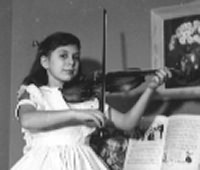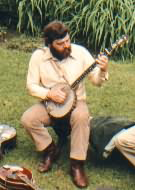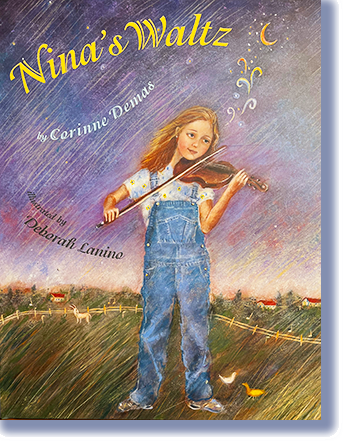Now Nina thinks her father is the
best fiddler in the state, maybe even the whole country. As they drive along
in the early morning light to a fiddle contest, she's sure he'll win first
place. After all, he's planning to play his new tune, the special one he
wrote for her birthday, "Nina's Waltz."
But there's an accident, and Nina's father
can't perform. Before he realizes it, another musician -- someone who's
afraid to play in front of strangers -- picks up his fiddle and heads for
the stage.
(Listen to "Nina's Waltz".)
Behind the Scenes
Deborah
Lanino used two girls to model for the part of Nina in the story.
She needed someone who played violin, and she advertised at Third
Street Music School Settlement in New York. By coincidence Third Street
Music School is where I learned to play the violin when I was a girl.
You can read all about it in my memoir, Eleven
Stories High: Growing Up in Stuyvesant Town, 1948--1968. Third
Street Music School Settlement is in a new building now on Eleventh
Street, but it's kept its original name.
I was a girl.
You can read all about it in my memoir, Eleven
Stories High: Growing Up in Stuyvesant Town, 1948--1968. Third
Street Music School Settlement is in a new building now on Eleventh
Street, but it's kept its original name.
Here I am playing the violin when I was around Nina's age.
Alex Demas (who is my cousin) wrote
the original music for Nina's Waltz. He was inspired by two
titmice who were calling to each other -- the opening measures of
the tune he wrote is based on their song. Deborah Lanino has incorporated
these birds in her illustrations. See if you can spot them!
Alex was founder and director of
the Lowell Annual Banjo and Fiddle Contest. He was a ranger at Lowell National Historical Park and for fifteen
years was the only music specialist in the National Park Service.
"Cottonmill Girls," his popular recording of immigrant songs
and mill tunes, is available at Eastern National Parks and Monuments.
On the tape Alex plays not only fiddle, but banjo, mandolin, guitar,
mountain dulcimer and autoharp.
Reviews
A hymn to the transforming power of music. Nina's father is the best fiddler she knows -- "The best in the whole state. In the whole country." Early one morning, the two of them leave for a fiddle contest that offers a first prize of $200, money the family desperately needs. Her father plans to play "Nina's waltz," a song that he wrote for her birthday. After several wasps sting his hand and he is unable to play, Nina overcomes her own stage fright and takes his place. Demas's quiet story is accompanied by soft acrylic paintings that echo the peaceful, rural setting. Graceful musical notes appear throughout, dancing serenely across purple-and-blue skies.
-- School Library Journal
This is a charming tale about the magic of violin music and the loving bond between father and daughter. The author, using simple yet softly lyrical prose, shows us a glimpse into a young girl’s life and her resolution not to let her dad down. This is also a story about the power of self esteem and believing in oneself. The illustrations are beautiful and even dream-like at times, bringing to life the countryside, Nina, and the ethereal magic of violin music. This would make a lovely present to any little violin player, especially a girl.
-- Mayra's Secret Bookcase
Illustrator
Deborah Lanino wanted to be an artist for as long as she can remember. She holds a Bachelor of Fine Art from Pratt Institute and a Master’s Degree from Argosy University. She also studied art abroad at SACI in Florence, Italy.
abroad at SACI in Florence, Italy.
Deborah is the illustrator of two other picture books: The Littlest Angel, by Charles Tazewell and Maria's Comet, by Deborah Hopkinson.
She is based in Los Angeles, where she taught college art for over 10 years while exhibiting in galleries and museums throughout New York, California, Massachusetts and Florida. Her first solo exhibit: “Reimagining: Faith, Hope and Love will be in the Fall of 2024 at the Blackfriars Gallery in Berkeley, CA. Check out her web site, www.deborahlanino.com and instagram@deborahlanino.


